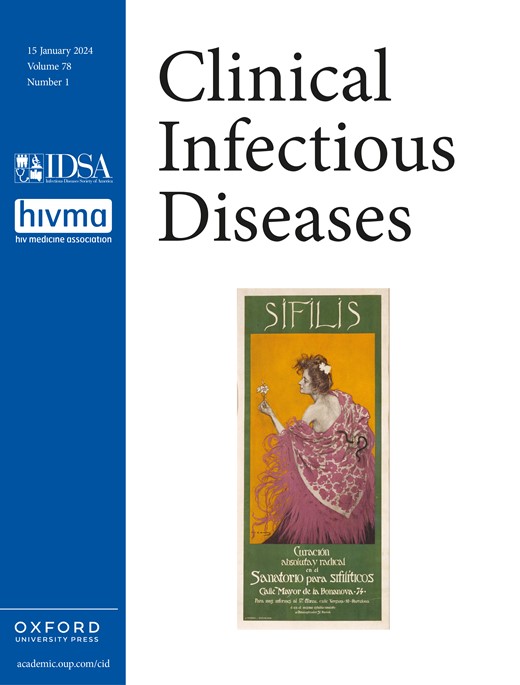Modeling the impact and cost of a culture-dependent molecular test for antimicrobial resistance in resource-limited settings.
IF 8.2
1区 医学
Q1 IMMUNOLOGY
引用次数: 0
Abstract
BACKGROUND Limited diagnostic access in resource-limited settings contributes to poor health outcomes among bacterial sepsis patients and the spread of antimicrobial resistance (AMR). Molecular diagnostic profiling of AMR may enable faster targeting of antibiotic therapies, improving clinical outcomes, reducing AMR development, and saving costs. METHODS We modeled the impact of a culture-dependent molecular diagnostic for pathogen identification and resistance testing among hospitalized bloodstream infection patients to guide effective and cost-efficient implementation of these tools. We evaluated patient mortality, antibiotic use, hospital-associated infections, hospital days, and costs under the standard-of-care (empiric therapy, blood culture, phenotypic susceptibility testing) compared to molecular diagnostics - varying culture and susceptibility testing coverage, culture turnaround time, and AMR prevalence. RESULTS The greatest impact of the molecular diagnostic occurred with 100% diagnostic coverage of all patients, shorter culture turnaround time, and high AMR prevalence, reducing up to 6% of deaths [IQR: 0-12.1%], 5% of hospital days [IQR: 0.1-10.7%], and 21% of days on inappropriate antibiotic therapy [IQR: 18.2-24.4%]. The minimum cost per molecular diagnostic performed, offset by cost savings, ranged from $109 in India to $585 in South Africa across all modeled scenarios. CONCLUSIONS In high AMR burden settings with blood culture infrastructure supporting fast turnaround times, a molecular diagnostic could improve bloodstream infection health outcomes. This impact is limited by delayed turnaround times and the effectiveness of empiric therapy. Molecular diagnostics implemented at $100 or less can generate healthcare system cost savings, supporting their adoption to improve health outcomes and reduce AMR while remaining cost neutral.在资源有限的环境中,模拟依赖培养的抗菌素耐药性分子测试的影响和成本。
背景:在资源有限的环境中,有限的诊断可及性导致细菌性脓毒症患者的健康结果不佳和抗菌素耐药性(AMR)的传播。AMR的分子诊断谱可以使抗生素治疗的靶向更快,改善临床结果,减少AMR的发展,并节省成本。方法我们模拟了培养依赖分子诊断对住院血液感染患者病原体鉴定和耐药性检测的影响,以指导这些工具的有效和经济有效的实施。我们评估了患者死亡率、抗生素使用、医院相关感染、住院天数和标准护理(经验性治疗、血培养、表型敏感性测试)下的成本,并与分子诊断(不同的培养和敏感性测试覆盖率、培养周转时间和AMR患病率)进行了比较。结果分子诊断的影响最大,所有患者的诊断覆盖率为100%,培养周转时间较短,AMR患病率高,最多可减少6%的死亡[IQR: 0-12.1%], 5%的住院天数[IQR: 0.1-10.7%], 21%的抗生素治疗不适当的天数[IQR: 18.2-24.4%]。在所有模拟情景中,每个分子诊断的最低成本(被节省的成本抵消)从印度的109美元到南非的585美元不等。结论在AMR负担高、血培养基础设施支持快速周转时间的环境中,分子诊断可改善血流感染的健康结局。这种影响受到周转时间延迟和经验性治疗有效性的限制。以100美元或更低的价格实施分子诊断可以节省医疗保健系统的成本,支持采用分子诊断来改善健康结果和减少抗菌素耐药性,同时保持成本中性。
本文章由计算机程序翻译,如有差异,请以英文原文为准。
求助全文
约1分钟内获得全文
求助全文
来源期刊

Clinical Infectious Diseases
医学-传染病学
CiteScore
25.00
自引率
2.50%
发文量
900
审稿时长
3 months
期刊介绍:
Clinical Infectious Diseases (CID) is dedicated to publishing original research, reviews, guidelines, and perspectives with the potential to reshape clinical practice, providing clinicians with valuable insights for patient care. CID comprehensively addresses the clinical presentation, diagnosis, treatment, and prevention of a wide spectrum of infectious diseases. The journal places a high priority on the assessment of current and innovative treatments, microbiology, immunology, and policies, ensuring relevance to patient care in its commitment to advancing the field of infectious diseases.
 求助内容:
求助内容: 应助结果提醒方式:
应助结果提醒方式:


